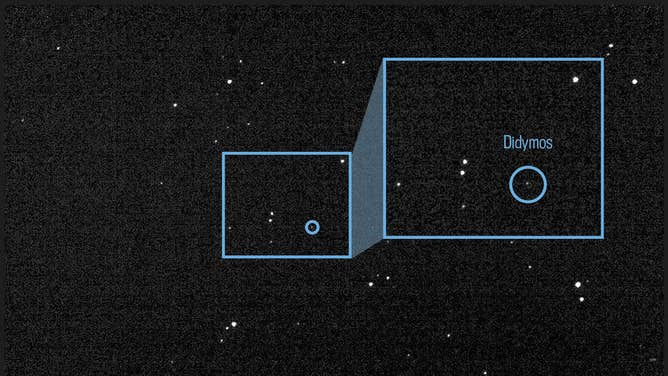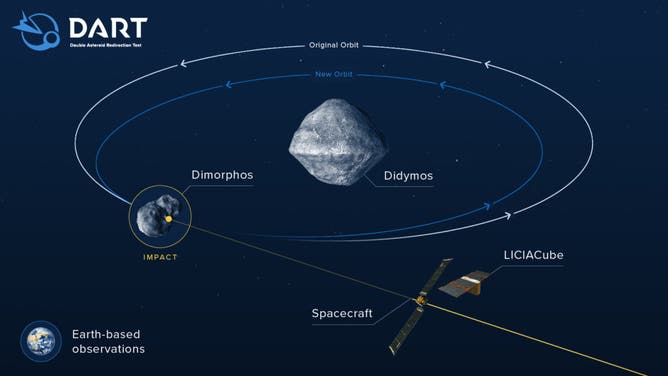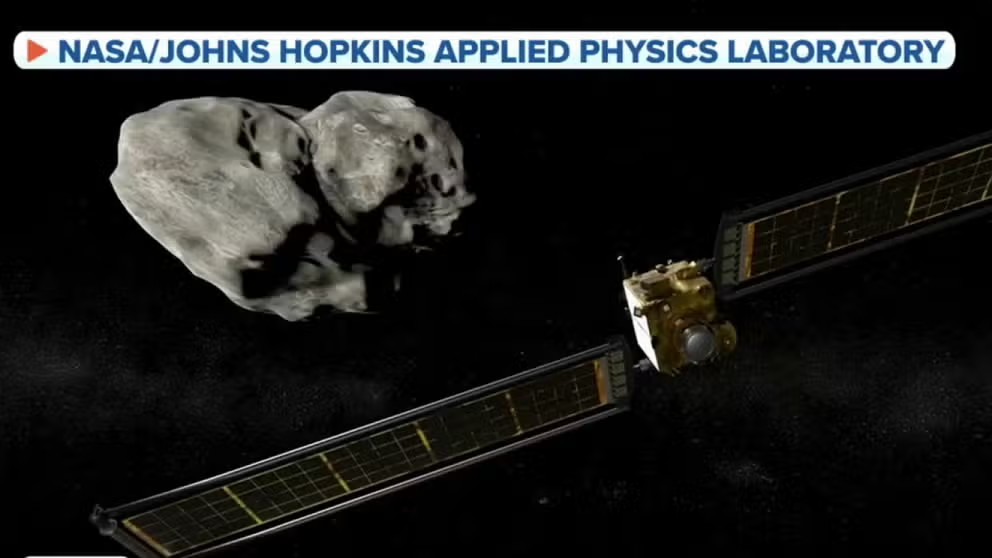NASA team confident it will successfully kill its DART spacecraft after asteroid collision
DART will test the kinetic impactor theory using the spacecraft as a battering ram at 15,000 mph and crashing it into the moonlit Dimorphos, which is orbiting the larger asteroid Didymos. The NASA spacecraft will autonomously navigate to its end on Sept. 26.
NASA DART Spacecraft to Smash Into Asteroid
NASA's spacecraft DART will crash into an asteroid to test a planetary defense theory.
Usually associated with bad news, hearing the phrase "loss of signal" will be a reason to celebrate for the team behind NASA's DART spacecraft scheduled to run smack into an asteroid on Monday.
Most NASA spacecraft last years or even decades but not the Double Asteroid Redirect Test mission. This space robot has a date with death.
NASA Planetary Defense Officer Lindley Johnson told reporters Thursday he is "highly confident" DART will hit its target and be a success.

This image of the light from asteroid Didymos and its orbiting moonlet Dimorphos is a composite of 243 images taken by the Didymos Reconnaissance and Asteroid Camera for Optical navigation (DRACO) on July 27, 2022. (Credits: NASA JPL DART Navigation Team)
After launching last fall with SpaceX, the appliance-sized spacecraft has been chasing down the binary asteroid system Didymos to test out a game plan to save Earth when a giant space rock heads toward our planet. The method known as the kinetic impacter theory involves using DART as a battering ram at 15,000 mph and crashing it into the moonlit Dimorphos, which is orbiting the larger asteroid Didymos.
IMAGES FROM ASTEROID-SMASHING DART MISSION EXPECTED TO BE 'STUNNING'
DART Mission Systems Engineer Elena Adams with Johns Hopkins University Applied Physics Laboratory, managing the mission for NASA, explains about 4 hours before impact, DART will be working autonomously to navigate to its end.
Using a relative-navigation system called SMART Nav, DART will hone in on Didymos about an hour before impact, and then slowly, the smaller Dimorphos will come into focus. The spacecraft will be sending back imagery at about one image per second.
"You'll hear us saying, 'We're precision lock, which means we are now starting to ignore Didymos, and we're going to Dimorphos … Then at two and a half minutes before impact Smart NAV … is going to turn off, and we're just going to point the camera and take the most amazing pictures of this asteroid that we're going to see for the first time," Adams said.
Dimorphos, only about 530-feet-wide, won't be fully in focus and clear until just moments before impact. The last image will be taken about 2.5 seconds before DART flies into the asteroid. Because of the 8-second delay from DART's signal to Earth, photos will continue to come through into the mission operations center in Maryland.
While DART will send back images until the end, its companion satellite, a tiny Italian CubeSat called LICIACube, will fly past the asteroid and continue to send back pictures in the days and months after the impact. The James Webb Space Telescope, ground-based observatories and other spacecraft will also be able to observe the asteroid impact from a distance.

DART and LICIACube shown on a graphic with the binary asteroid system Didymos and Dimorphos. (Image: NASA/ JHUAPL)
Although it's never been done before, NSA DART scientist Tom Statler says the team has a good idea of what happens when you run a spacecraft into an asteroid because of NASA and Japanese Space Agency missions to other asteroids.
"We know that DART is going to be stopped by Dimorphos for one reason," Statler said. "The density of the DART spacecraft is actually not very different from the density of an asteroid. And so there's no question that DART is going to run into a whole lot of material that can't get out of the way."
DART won't change the orbit of Didymos. It aims to change the speed of the moonlet, Dimorphos, by just a tiny percentage.
"We're moving an asteroid. We are changing the motion of a natural celestial body in space," Statler said. "Humanity has never done that before … this is stuff of science fiction."
WHY 'ARMAGEDDON' PLOT IS NOT EARTH'S BEST DEFENSE FROM ASTEROIDS
DART Project Manager Edward Reynolds said he's not losing sleep over the upcoming impact because the team has run simulations and tested the spacecraft navigation since launch, but that doesn't mean hitting a 100-meter-diameter asteroid at 14,000 mph isn't a difficult task.
"We do things because they're hard. We are at the point where technology is emerging so that we can use these emerging technologies to protect ourselves against these threats," Reynolds said. "I think we've prepared ourselves for this moment, but I don't worry about the spacecraft. I don't worry about the algorithm."
If DART does its job, it will stop sending back a signal after 7 p.m. ET on Monday.
"And then we'll celebrate," Adams said.
